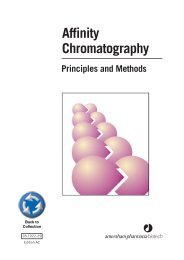Mutation of YCS4, a Budding Yeast Condensin Subunit - Molecular ...
Mutation of YCS4, a Budding Yeast Condensin Subunit - Molecular ...
Mutation of YCS4, a Budding Yeast Condensin Subunit - Molecular ...
You also want an ePaper? Increase the reach of your titles
YUMPU automatically turns print PDFs into web optimized ePapers that Google loves.
<strong>Condensin</strong> Function and Chromosome BehaviorFigure 2. Cohesin binding and displacementis normal in ycs4-1. (A) Cohesinsubunit Mcd1p/Scc1p was localizedby indirect immun<strong>of</strong>luorescenceon chromosome spreads in wild-type(SBY376) and ycs4-1 (NBY284) strainscontaining 3XHA-epitope taggedMcd1p/Scc1p. Samples were fixed andstained at the indicated times during asynchronous cell cycle at the nonpermissivetemperature (37 o C). DNAstaining (DAPI) is shown in the leftpanels, anti-LacI antibody staining isshown in the middle panels, and anti-HAantibody staining is shown inthe right panels. G1, S phase, and anaphasespreads prepared from wildtype(top) and ycs4-1 (bottom) cells areshown. Mcd1p is absent from G1 andanaphase spreads but is present onspreads from cells in S phase in bothwild-type and ycs4-1. Bar, 10 m. (B)Quantified results <strong>of</strong> Mcd1p localizationto chromosomes. The percentage<strong>of</strong> chromosomes with Mcd1p localizedto chromosome spreads is representedversus time for wild type (SBY376) andycs4-1 (NBY284).association and dissociation <strong>of</strong> Mcd1p/Scc1p are the same inthe two strains. Thus, sister chromatid separation in ycs4-1mutants is defective despite the removal <strong>of</strong> cohesins fromchromosomes in anaphase. The similarity to the phenotype <strong>of</strong>top2-4 suggests that the condensin complex, which containsYcs4p, may be required for the rapid resolution <strong>of</strong> the topologicallinkage between sister chromatids; alternatively, thecondensins may be responsible for the abolition <strong>of</strong> a previouslyunsuspected, cohesin-independent, proteinaceous linkage.<strong>YCS4</strong> Regulates Localization <strong>of</strong> Topoisomerase Iand IIBecause the lack <strong>of</strong> <strong>YCS4</strong> function results in a top2-4-likephenotype, we asked whether <strong>YCS4</strong> function was requiredto localize topoisomerase II. <strong>YCS4</strong> and ycs4-1 strains thatcontained epitope-tagged TOP2 were arrested in G1 at 23°Cand released into fresh media at 37°C. Images <strong>of</strong> the chromosomespreads are shown in Figure 3A and the data arequantified in Figure 3B. Wild-type nuclei maintained apunctate Top2p association throughout the cell cycle (Figure3, A and B). However, more than half <strong>of</strong> the ycs4-1 nuclei losttheir Top2p staining within 30 min <strong>of</strong> the temperature shiftto 37°C (Figure 3, A and B). Immunoblotting <strong>of</strong> cell lysatesverified that the Top2p protein was still present in ycs4-1despite the loss <strong>of</strong> the protein from chromsome spreads (ourunpublished results). We also observed a loss <strong>of</strong> topoisomeraseI from ycs4-1 chromosome spreads at the nonpermissivetemperature (Figure 3C). The pattern <strong>of</strong> topoisomeraseI staining on chromosome spreads is similar to that <strong>of</strong> topoisomeraseII staining, punctate and coincident with DNAstaining (our unpublished results).However, the ycs4-1 phenotype cannot be fully explainedby the loss <strong>of</strong> topoisomerase II from chromosomes. Overexpression<strong>of</strong> Top2p does not suppress the temperature sensitivityor sister separation phenotype <strong>of</strong> ycs4-1 despite restoration<strong>of</strong> Top2p to chromosomes as visualized bychromosome spreads (our unpublished results). A simpleinterpretation <strong>of</strong> this failure is that the condensin complexhas general effects on mitotic chromosome structure and thatTop2 is only one <strong>of</strong> several proteins whose chromosomallocalization and function has been compromised.Ycs4p Is Nuclear throughout Cell Cycle and IsEnriched at rDNA at AnaphaseTo gain a greater understanding <strong>of</strong> <strong>YCS4</strong>’s role in mitoticchromosome behavior, we localized Ycs4p by indirect immun<strong>of</strong>luorescenceon both whole cells (Figure 4) and chromosomespreads (our unpublished results). In frogs andfission yeast, the condensin complex is only associated withchromatin or in the nucleus during mitosis (Hirano et al.,1997; Sutani et al., 1999). Our experiments reveal that Ycs4pwas present in the nucleus (Figure 4, A and B) and associatedwith chromatin (our unpublished results) throughoutthe budding yeast cell cycle. This is consistent with thefindings <strong>of</strong> Freeman et al. (2000). The only observable shift inlocalization occurred at anaphase when a general staining <strong>of</strong>the nucleus was replaced by specific staining <strong>of</strong> the nucleolus(detected by the nucleolar marker Nop1p; Aris andBlobel, 1988) (Figure 4C); cells arrested in metaphase byoverexpression <strong>of</strong> Mps1p did not exhibit this subnuclearlocalization (our unpublished results). In cells in which thechromosomal rDNA had been deleted and replaced with asingle copy <strong>of</strong> the repeat on a 2- plasmid (rdn) (Nierras etal., 1997), there was no anaphase relocalization and Ycs4pwas diffusely nuclear throughout the cell cycle (Figure 4D).This effect is not due to the presence <strong>of</strong> the plasmid-borneVol. 13, February 2002 637
















